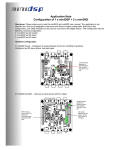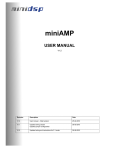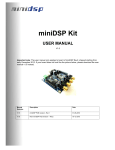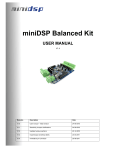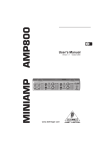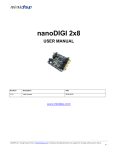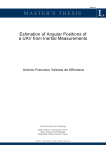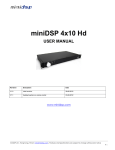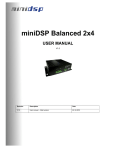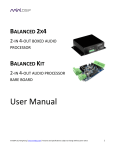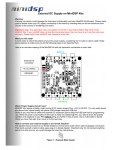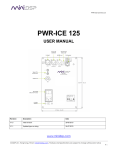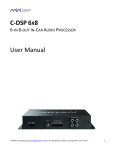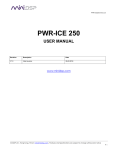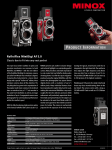Download miniDIGI User Manual
Transcript
miniDIGI I/O card USER MANUAL V1.3 Revision Description Date V1.0 User manual – Initial version 25-02-2010 V1.1 Updated section on Digital/Analog toggle switch 05-05-2010 V1.2 Updated diagrams for I2S section 02-06-2010 V1.3 Updated general descriptions 01-02-2011 1 Board connectivity 1.1 Board diagram Toslink 1 Toslink 2 SPDIF 2 SPDIF 1 Source selection header Expansion connector J16 Expansion connector J2 Master/Slave jumper I2S channel selection header DC in SPDIF OUT Optical OUT Expansion Connector J16 Pin Description Pin Description 1 n/a 2 n/a 3 n/a 4 n/a 5 Ground 6 Ground 7 Ground 8 Ground 9 MCLKIN 10 I2S_DATA_IN1&2 11 I2S_DATA_IN3&4 12 I2S_DATA_IN5&6 13 I2S_DATA_IN7&8 14 I2S_IN_LRCLK 15 I2S_IN_BCLK 16 I2S_DATA_OUT1&2 17 I2S_DATA_OUT3&4 18 I2S_DATA_OUT5&6 19 IS2_DATA_OUT7&8 20 I2S_OUT_LRCLK 21 I2S_OUT_BCLK 22 3.3V 23 n/a 24 3.3V 25 GND 26 GND 27 n/a 28 n/a 1.2 Input Source Selection The miniDIGI has a total of 4 inputs: - 2 x SPDIF on RCA connectors with isolation transformers - 2 x Toslink connection on Optical receivers However, only one signal can be selected at a time using a single jumper on a 2 x 4 header. Warning that placing more than one jumper could damage the board and void your warranty. Toslink#1 Toslink#2 SPDIF#1 SPDIF#2 BBM switch toggling between SPDIF1/2 Toslink 1/2 Select one of the inputs SPDIF #1 SPDIF #2 Toslink #1 Toslink #2 Zoomed up with jumpers 1.3 Break Before Make switching miniDIGI Power options miniDIGI boards may receive power from multiple ways: o In a stacked configuration, from another miniDSP board powered by USB. o In a stacked configuration, from another miniDSP or miniAMP powered by DC supply o Locally, a DC connector can be soldered to the board with an external supply ranging from 4.5 to 24VDC 2 I2S jumper configuration Configuration flexibility is a core design feature of the miniDSP concept. Using the I2S (Inter IC Sound) protocol, synchronized data is shared between between boards. Besides the advantages of better noise immunity (vs analog audio), the choice of the widely known I2S protocol allows design & customization freedom. I2S protocol consists of the following signals: - Clocks: They provides synchronization between ICs - I2S_IN: I2S input data lines carrying 2 x 24bit audio channels, in sync with the clocks - I2S_OUT: I2S output data lines carrying 2 x 24bit audio channels, in sync with the clocks Looking at the typical audio flow diagram of a miniDIGI board helps understand the system better: INPUTS SPDIF#1/2 Toslink#1/2 1 2 3 4 5 Source selection header Digital Audio Receiver Sample Rate Converter I2S header Source Selection Digital Audio Transmitter Selection of one of the input source I2S_IN I2S_IN I2S_IN I2S_IN ch1&2 ch3&4 ch5&6 ch7&8 Routing of 1xI2S_in & 1xI2S_out I2S_OUT I2S_OUT I2S_OUT I2S_OUT OUTPUTS ch1&2 ch3&4 ch5&6 ch7&8 SPDIF#1 Toslink#1 1. Audio inputs (SPDIF/TOSLINK) are connected to a source selection header where the user can select 1 out of the 4 sources. 2. Signal is then fed to the Digital Audio Receiver which translates the SPDIF/Toslink signal to an I2S signal 3. The sample rate converter (SRC) is next in line to insure the input signal is compatible with the miniDSP configured sample rate (48kHz) 4. The next step is the I2S routing, i.e. the routing of a digital signal to the I2S bus shared between boards in a stacked configuration (link cables). As shown in the diagram below, using jumpers, one can decide to route the I2S data signal on any I2S channels of the expansion bus. SPDIF or Toslink Input SPDIF or Toslink Input Jumper selects which I2S channel the SPDIF input signal is being routed to. Jumper selects which I2S channel the SPDIF output receives. 5. Finally, I2S_OUT jumpers allow you to configure which channel you want to convert from I2S to SPDIF/Toslink if it is ever required. Step by Step configuration Please pay attention to the following diagram to clearly understand how to route your data to the correct pin. Incorrect configuration could create a short circuit and damage your board. 1. The first step consists in reading the plug-in datasheet to figure out which I2S channels will be available from the miniDSP kit. This information is useful to understand how external I/O cards can link up to the miniDSP kit. Taking for example the Crossover plugin, you can read in the technical specification section: Digital Inputs Digital Outputs Plug-in IN#1&2 selectable on I2S_Data_In7&8 Plug-in OUT#1/2/3/4 available on I2S_Data_Out1/2/3/4 Un-processed signal from ADC on I2S_Data_Out5/6 Un-processed signal from Digital IN on I2S_Data_Out 7/8 In other words: - If you want to send the SPDIF input signal for processing on the miniDSP kit, you need to route the miniDIGI to the plug-in inputs, in other words place a jumper on I2S_Data_in7&8 channels - If you want OUT#3&4, post plug-in processing by the miniDSP, to be converted to SPDIF out on the miniDIGI, you will need to “grab” I2S_Data_Out3&4 from the expansion bus. See the example below for exact location of jumpers for that template configuration. Here is a zoomed up version of the I2S routing header: Using jumpers, route the I2S data to the correct channel. 3 Outputs 2 1 0 Inputs 3 2 1 0 Master/ Slave Jumper I2S_Data_IN_ch7&8 I2S_Data_IN_ch5&6 I2S_Data_IN_ch3&4 I2S_Data_IN_ch1&2 I2S_Data_OUT_ch7&8 I2S_Data_OUT_ch5&6 I2S_Data_OUT_ch3&4 I2S_Data_OUT_ch1&2 Always closed for SCLK & LRCLK MCLK selection Jumper symbol: To prevent potential damage with short-circuits, these rules should be followed at all times: - Select only one SPDIF/Toslink source from the input source selection header - Select only one I2S_Data_OUT lines on the I2S routing header I2S Master/Slave configuration To allow stacking of multiple boards on top of each other, miniDIGI have the capability to run as: • I2S master – Jumper removed (open): The board outputs clocks (LRCK/SCLK). This configuration applies to the following board combinations: o miniDIGI + miniAMP o miniDIGI + external D/A • I2S slave – Jumper in place (closed): The board receives clocks from another I2S device master. This configuration applies to the following combinations: o miniDIGI + miniDSP o miniDIGI + 2 x miniDSP Loopback mode miniDIGI board can be configured in a loop-back mode for either SPDIF de-jittering or daisy chaining of multiple miniDIGI boards. A single jumper placed vertically between inputs and outputs is all you need to link-up the incoming SPDIF stream to the SPDIF output. 3 1 Outputs 2 0 2 Inputs 3 Loop back mode enabled when jumper in place at this location. 1 0 Note that in a loop back mode, audio will effectively go through 2 x miniDIGI and introduce 2.88ms of delay in the path. In other words, all outputs of the first board will need to be delayed by 2.88ms to make sure audio is correctly time aligned. miniDSP 1 SPDIF Input miniDSP 2 SPDIF loop back miniDIGI 1 miniDIGI 2 Delay all outputs of this stack only minDIGI template configurations miniDIGI may be configured in a multitude of ways and the following configurations are only some illustrations of the board’s potential. Option 1: Quick configuration To simplify your task, summarized jumper charts can be downloaded from the Download section of our website o 2 way configuration jumper charts o 3/4way configuration jumper charts Option 2: Advanced configuration For those of you who want to understand more about what they are doing, the following board stacking configuration will illustrate some typical jumper configurations. Stereo 2 Way configuration 3 1 Outputs 2 Digital signal Analog signal 0 miniDIGI SPDIF/Toslink Un-Processed signal 2 Inputs To amplifier 3 miniDSP 1 0 SPDIF/ Toslink Option1 In a very similar configuration as above setup, but this time two miniDIGI boards are linked up together with an SPDIF link. With this creative configuration, a single miniDSP is able to power 2 miniAMP + miniDIGI configurations for a truly digital solution! Template Jumper configuration: Stereo 2 Way configuration To Speakers miniAMP #1 miniAMP #2 miniDSP SPDIF/ Toslink miniDIGI #1 Link Up SPDIF In this stereo 2way configuration, Audio comes from the SPDIF input on the miniDIGI board. miniDIGI I2S audio SPDIF input was routed to I2S_Data_IN_ch7&8 by placing the jumper in the correct location (Jumper location 0) The Analog outputs of the miniDSP are being sent to a multi-channel amplifier for each way. For future expansion (or linking to another device), the miniDIGI was also configured to loop back mode to output the de-jittered SPDIF signal to another device. Please see the note below about miniDIGI loop back mode. To Speakers miniDIGI #1 (SPDIF in -> I2S_Data_IN_ch7&8) miniDIGI #1 (I2S_Data_OUT_ch3&4 - > SPDIF OUT) miniDSP #1 (Slave Clock, configured for I2S source in plug-in) miniAMP #1 (I2S_Data_OUT_ch1&2) miniDIGI #2 (Loop-back mode + Jumper I2S_Data_OUT_ch7&8) miniAMP #2 (I2S_Data_OUT_ch7&8) miniDIGI #2 Please see the note below the loop back mode. Stereo 4 Way configuration RIGHT LEFT SPDIF/ Toslink miniDSP #1 4 ch Amplifier miniDSP #2 miniDIGI #1 SPDIF/Toslink miniDIGI #2 4 ch Amplifier Finally, this stereo 4 way configuration displays a Left & Right active speaker configuration where 4ch amplifiers or miniAMP modules may be used to build an all digital configuration. Template Jumper configuration: miniDIGI #1 (SPDIF in -> I2S_Data_IN_ch7&8) miniDIGI #1 (Loop-back for un-processed audio to SPDIF out) miniDSP #1 (Slave Clock, configured for I2S source in plug-in) miniAMP #1 (I2S_Data_OUT_ch1&2 + I2S_Data_OUT_ch3&4) miniDIGI #2 (SPDIF in -> I2S_Data_IN_ch7&8) miniDSP #2 (Slave Clock, configured for I2S source in plug-in) miniAMP #2 (I2S_Data_OUT_ch1&2 + I2S_Data_OUT_ch3&4) Digital / Analog source selection via toggle switch Control of I2S vs Analog source selection is performed from a radio button inside the miniDSP plug-in (read miniDSP user manual for more information). Using the I2S data lines, it’s however possible to toggle between the Analog inputs of the miniDSP and Digital inputs of the miniDIGI with the following work around. Here are the steps to follow: - Configure the miniDSP plug-in to I2S input. On all miniDSP plug-ins, this means that audio needs to be fed to I2S_DATA_IN7&8 pins for processing by the miniDSP - Knowing that the un-processed signal from the ADC of a miniDSP is also available on I2S_DATA_IN5&6, we can toggle between analog (from the ADC on miniDSP) and Digital (from the miniDIGI) with a toggle switch located as below diagram: 3 1 Outputs 2 SPDIF 0 3 1 Inputs 2 ADC Toggle Switch 0 Note that toggling between 2 modes should either be done with power OFF or using “Brake before Make” switches to prevent any potential short circuits. Troubleshooting The following symptoms were found to be the most likely cause of issues. Item# Symptoms Troubleshooting recommendation 1 No audio on outputs 2 miniDSP LED not flashing 2 High Frequency noise on signal Contact Us Problem unsolved by above suggestions Check your jumper configuration carefully: - I2S source selection - I2S routing configuration In 90% of cases, mis-configured jumper configuration will explain lack of audio In a stacked configuration with a miniDSP, make sure to configure the miniDSP board to Slave Clock (see manual) to be able to receive the master clock from the miniDIGI board This is a typical symptom of an incorrectly configured MCLK (Master/Slave) on a miniDSP and miniDIGI configuration. Please make sure to double check the jumper chart for the correct configuration. - Have a look at our forums to see if someone else already had this issue. - Send us an email ([email protected]) with a clear explanation of the symptoms and descriptions of the troubleshooting steps you already followed. A picture of the jumper configuration is worth a thousand words… If not solved go to item Contact us Contact us n/a n/a








